When Storms Strike: Finding Help for Your Damaged Roof
A storm damage roofing company provides specialized services for homeowners whose roofs have been damaged by severe weather events. Here’s what to look for when choosing one:
- Local presence: Select a company with a permanent local office in your area
- Insurance expertise: Choose contractors experienced with the claims process
- Proper licensing: Verify they have appropriate credentials and insurance
- Written warranties: Ensure they offer clear guarantees on materials and workmanship
- Storm damage specialization: Look for teams trained in identifying and repairing specific storm damage
When severe weather strikes San Antonio, your roof stands as your home’s first line of defense. Unfortunately, high winds, hail, and heavy rainfall can leave behind significant damage that threatens the integrity of your entire home. According to industry statistics, hail storms alone cause approximately $1 billion in roof damage to homes and buildings across the United States each year. Wind and hail damage account for nearly 34% of all homeowners insurance claims between 2017 and 2021.
Finding a reputable storm damage roofing company after disaster strikes can feel overwhelming, especially when you’re already dealing with the stress of property damage. Many homeowners make costly mistakes by rushing to hire the first contractor who knocks on their door or by delaying repairs that could lead to more extensive damage.
I’m Carlos Yzaguirre, President of Apex Roofing & General Contractors, with extensive experience helping San Antonio homeowners recover from storm damage through our storm damage roofing company services that prioritize quality craftsmanship and customer satisfaction.
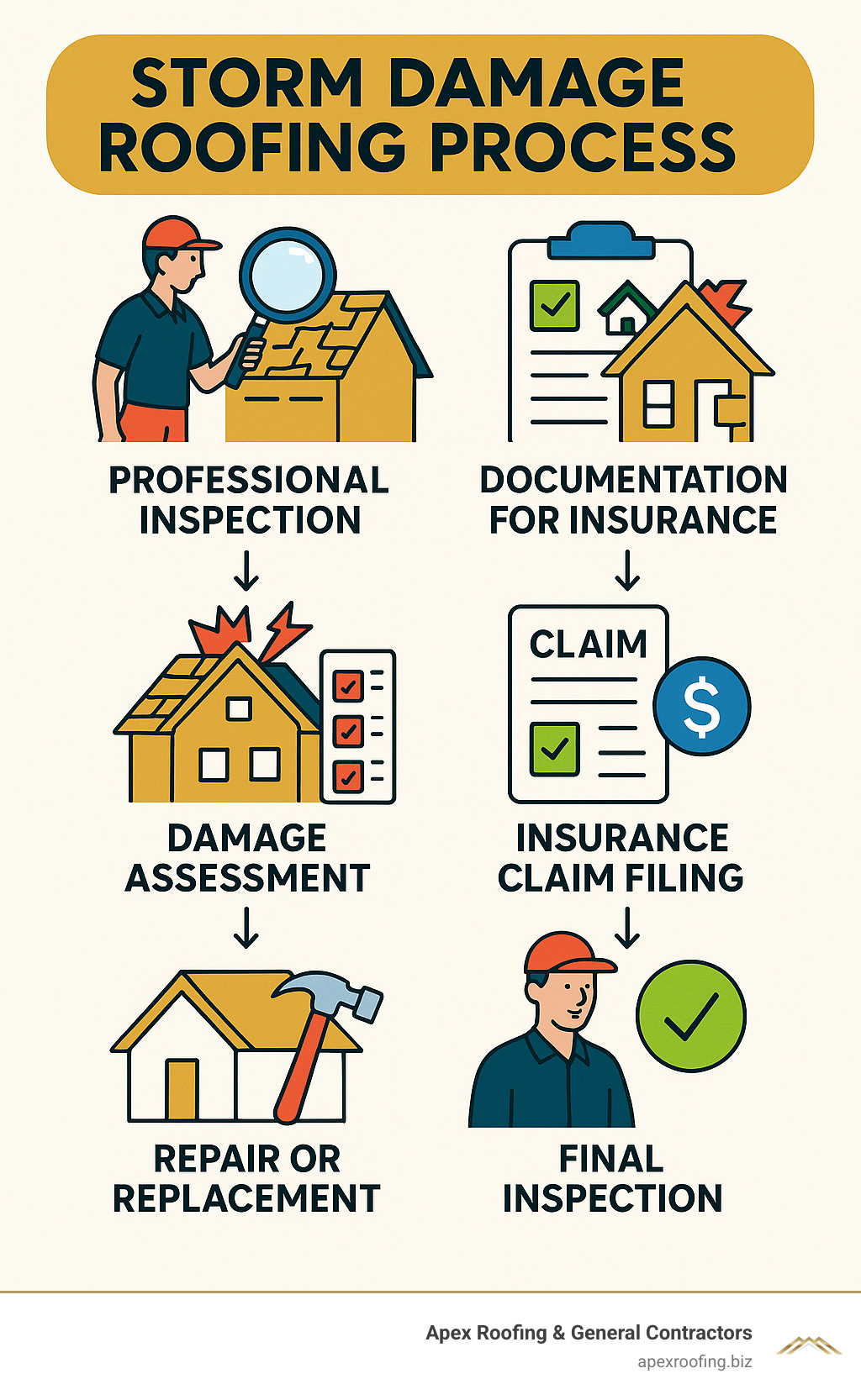
Storm Damage 101: Types & Warning Signs
When Mother Nature releasees her fury on San Antonio, your roof takes the brunt of the impact. Understanding what storm damage looks like helps you protect your most valuable investment – your home. Let’s explore the common types of storm damage we see across South-Central Texas and the warning signs that should have you reaching for the phone.
Hail Damage
Those ice pellets falling from the sky might look innocent enough, but they pack a serious punch against your roofing materials. When hail strikes your roof, it doesn’t always leave obvious holes – instead, it creates subtle damage that worsens over time.
Hail impacts typically create small dents or dimples in asphalt shingles that might not be visible from the ground. These impact points weaken your roof’s protective barrier, leading to premature aging and eventual leaks. On metal roofs, hail leaves visible denting, while wooden shingles may split or crack under the assault.
One of the most concerning effects is granule loss – those protective particles on asphalt shingles that get knocked loose during hailstorms. Without these granules, your shingles become vulnerable to UV damage and deteriorate much faster.
Wind Damage
Those powerful Texas gusts don’t just rattle your windows – they can wreak havoc on your roofing system. Wind uplift occurs when air pressure underneath your roof becomes greater than the pressure above it, literally lifting shingles away from your roof deck.
High winds commonly cause:
- Lifted, creased, or missing shingles
- Damaged flashing around chimneys and vents
- Loosened fasteners and roof components
- Entry points for water that lead to interior damage
Fallen Trees and Flying Debris
Severe storms often turn ordinary objects into projectiles. Fallen trees and large branches can puncture your roof or crush entire sections, while flying debris like lawn furniture or tree limbs can cause unexpected damage far from their original location.
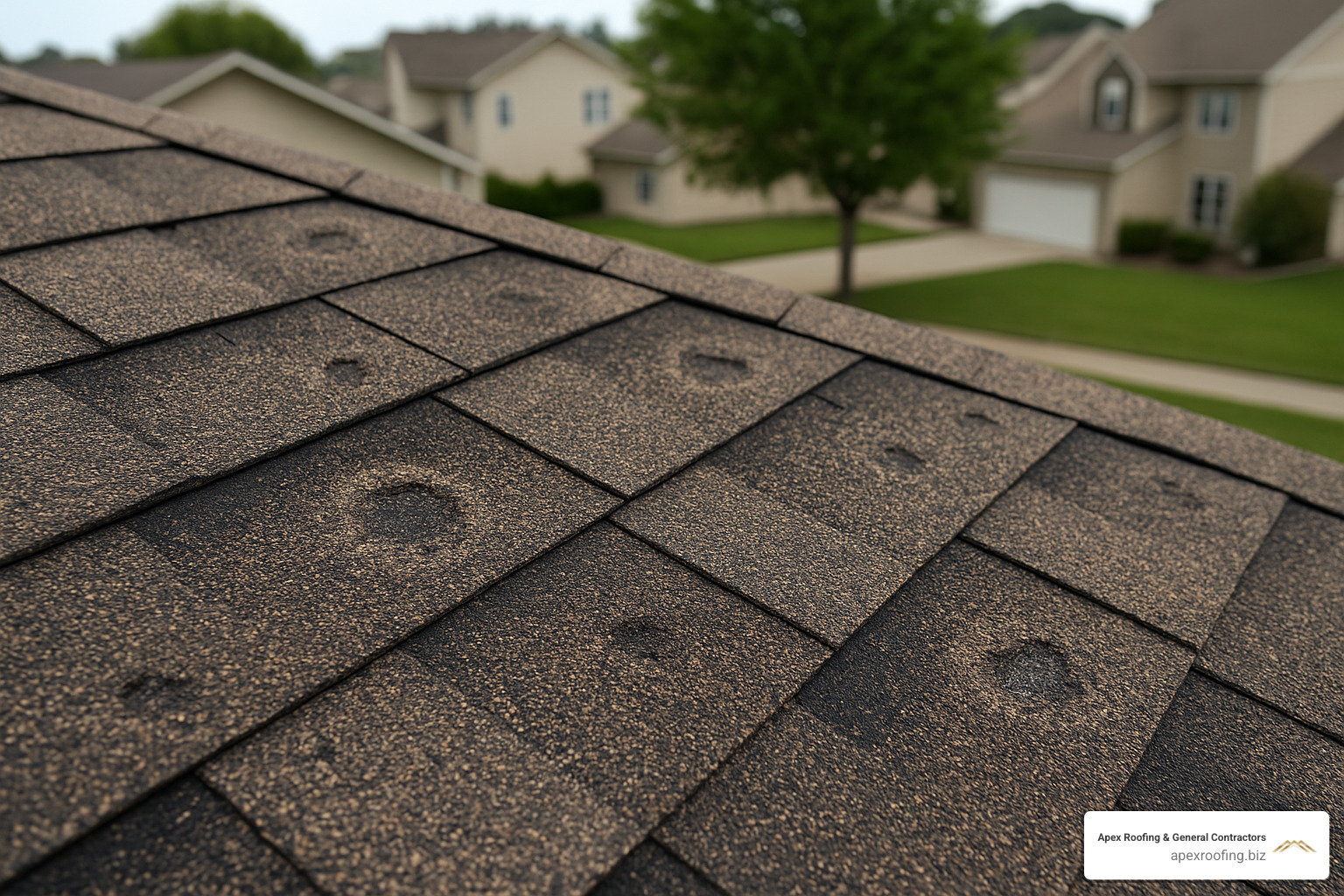
Warning Signs You Shouldn’t Ignore
Even if damage isn’t glaringly obvious, your home will give you clues that something’s wrong. Here are telltale signs your roof has sustained storm damage:
After a storm, check your gutters for unusual amounts of granule loss – those small, sandy particles from your shingles indicate hail impact. Inside your home, look for attic leaks or water stains on ceilings and walls, which suggest water has found its way through compromised roofing.
Pay attention to unexpected energy-bill spikes too. When your roof’s integrity is compromised, your heating and cooling systems work overtime to maintain comfortable temperatures. Any visible sagging areas require immediate professional attention, as do new mold or mildew growth patterns that signal ongoing moisture problems.
Did you know that over 60% of homeowners don’t realize their insurance may cover full roof replacement after storm damage? That’s why professional inspection by a qualified storm damage roofing company like Apex Roofing is essential – we identify all issues that might be covered by your policy.
The sooner you address storm damage, the less expensive and extensive repairs typically are. If you’ve recently experienced severe weather, don’t wait for small problems to become major headaches. Call (726) 727-7663 for a free inspection from our San Antonio roofing experts.
For more detailed information about our comprehensive storm damage repair services, visit our storm damage repair page. And if you’re interested in upgrading to more resilient materials for future protection, check out the latest storm-resilient shingle research that’s revolutionizing how we build stronger roofs.
First 24 Hours: Safety & Temporary Protection
The hours immediately following a severe storm can make all the difference in protecting your home from additional damage. When those dark clouds finally roll away, revealing potential roof damage, knowing exactly what to do can save you thousands in repairs.
Prioritize Safety First
Your family’s safety trumps everything else. If you notice water staining your ceiling or hear concerning creaks from above, it’s time to take precautions. Stay clear of rooms with sagging ceilings or water accumulation – that beautiful popcorn ceiling might look harmless, but when waterlogged, it can collapse without warning.
If water is dripping near light fixtures or electrical outlets, turn off power to those areas immediately. And while your instinct might be to grab a ladder and check things out yourself, resist that urge. Professional roofers have the proper safety equipment and training to steer damaged roofs without risking injury.
“I’ve seen too many homeowners end up in the emergency room after attempting DIY roof inspections,” says Carlos Yzaguirre, President of Apex Roofing & General Contractors. “A damaged roof is unpredictable and dangerous – leave the climbing to the professionals.”
Document Everything
Before you touch anything, grab your smartphone and start documenting. Take clear photos and videos of all visible damage from safe vantage points. This visual evidence will be invaluable when filing your insurance claim.
Be thorough in your documentation:
- Capture the date and time of the storm
- Make notes about unusual events during the storm (loud impacts, cracking sounds)
- Keep a detailed log of all conversations with insurance representatives
- Save weather reports that confirm severe conditions in your area
These details might seem minor now, but they can make the difference between a denied claim and full coverage later.
Apply Temporary Protection
Once you’ve documented everything and it’s safe to do so, taking steps to prevent further damage becomes your next priority.
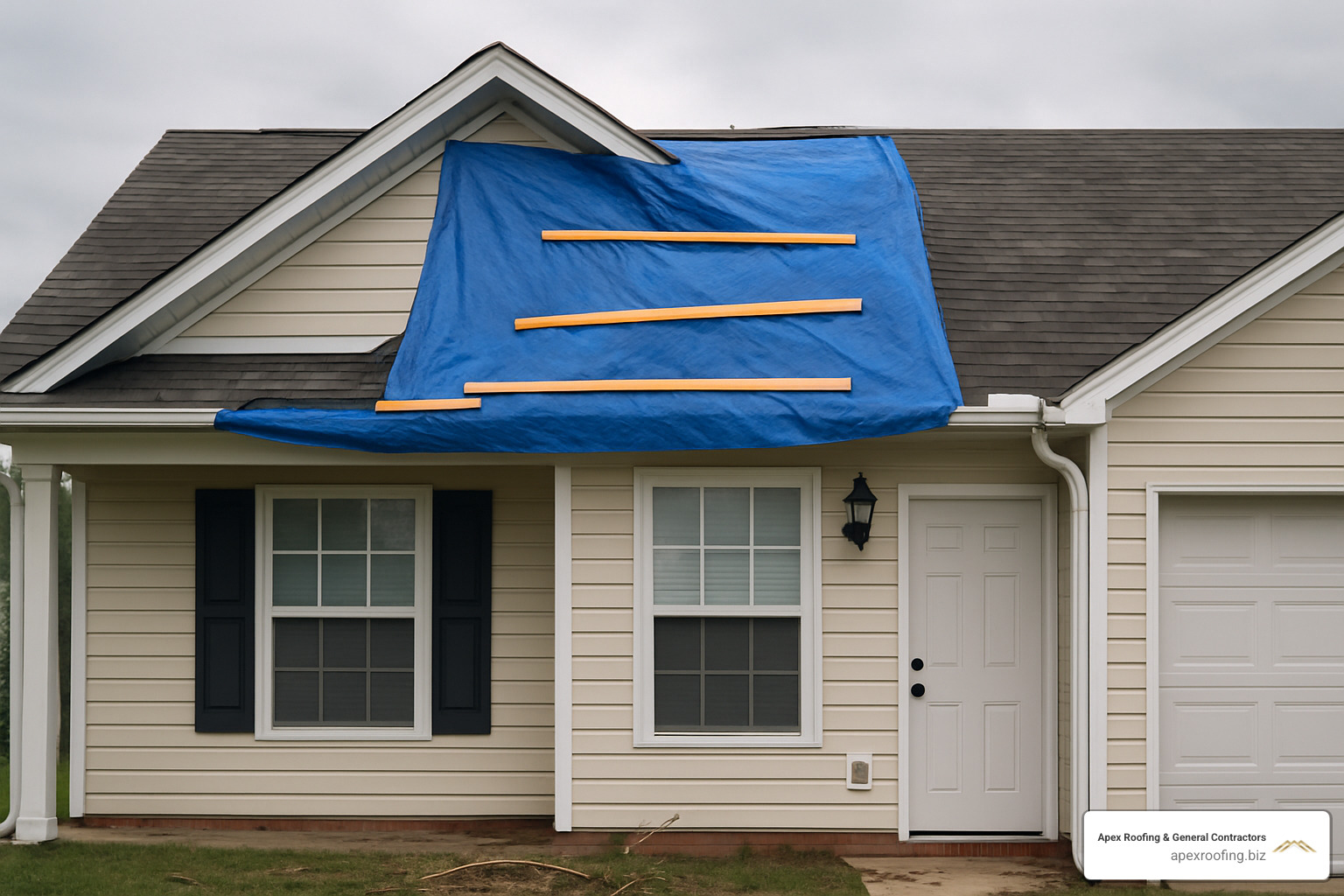
Tarping the Roof
While we always recommend professional tarping, we understand that immediate help isn’t always available during widespread storm events. Here’s an honest look at DIY versus professional approaches:
| Aspect | DIY Tarping | Professional Tarping |
|---|---|---|
| Safety | High risk for homeowners | Trained crews with safety equipment |
| Effectiveness | Often inadequate | Properly secured and waterproof |
| Longevity | May fail quickly | Can last weeks if needed |
| Insurance | May void certain claims | Documented by professionals |
| Cost | Materials only | Service fee but often reimbursable |
Interior Protection
Inside your home, quick action can prevent thousands in additional damage. Place buckets under active leaks to collect water. Move furniture, electronics, and sentimental items away from damaged areas. Large plastic sheeting can protect immovable furniture, and quickly removing standing water helps prevent mold growth, which can begin developing within just 24-48 hours.
Contact Professionals Immediately
After ensuring your family’s safety and applying temporary protection, it’s time to bring in the experts:
First, contact a reputable storm damage roofing company like Apex Roofing & General Contractors for emergency services. We prioritize storm damage calls and can often provide same-day emergency tarping.
Next, notify your insurance company about the damage. Many policies require prompt reporting, and delays could potentially affect your coverage.
Finally, schedule a professional roof inspection as soon as possible. A trained inspector can identify hidden damage that might not be visible to the untrained eye but could cause serious problems down the road.
For emergency roofing assistance in San Antonio and surrounding areas, visit our emergency roofing services page or call us at (726) 727-7663. Our teams are standing by, ready to help protect your home when you need it most.
Insurance Claims Deep Dive
Navigating the insurance claims process might feel like learning a foreign language, but don’t worry—I’m here to translate the complicated parts into plain English. Understanding this process is crucial to getting the coverage you deserve after a storm damages your roof.
Understanding Your Policy: ACV vs. RCV
One of the biggest “gotchas” in insurance policies is the difference between Actual Cash Value (ACV) and Replacement Cost Value (RCV):
Actual Cash Value (ACV): This only pays what your old roof is worth today—after depreciation. Imagine your 15-year-old roof would cost $15,000 to replace new. If it’s depreciated by 67%, you might only receive $5,000 (minus your deductible). Ouch!
Replacement Cost Value (RCV): This is the good stuff. It covers what it actually costs to replace your damaged roof with a new equivalent. That $15,000 roof replacement? You’d get the full amount (minus your deductible).
With RCV policies, there’s a twist—insurance companies typically pay in two installments. First comes the ACV payment (the depreciated value), then you get the remaining “recoverable depreciation” after you’ve completed the repairs. It’s like they want proof you actually fixed your roof before giving you all your money. Fair enough!
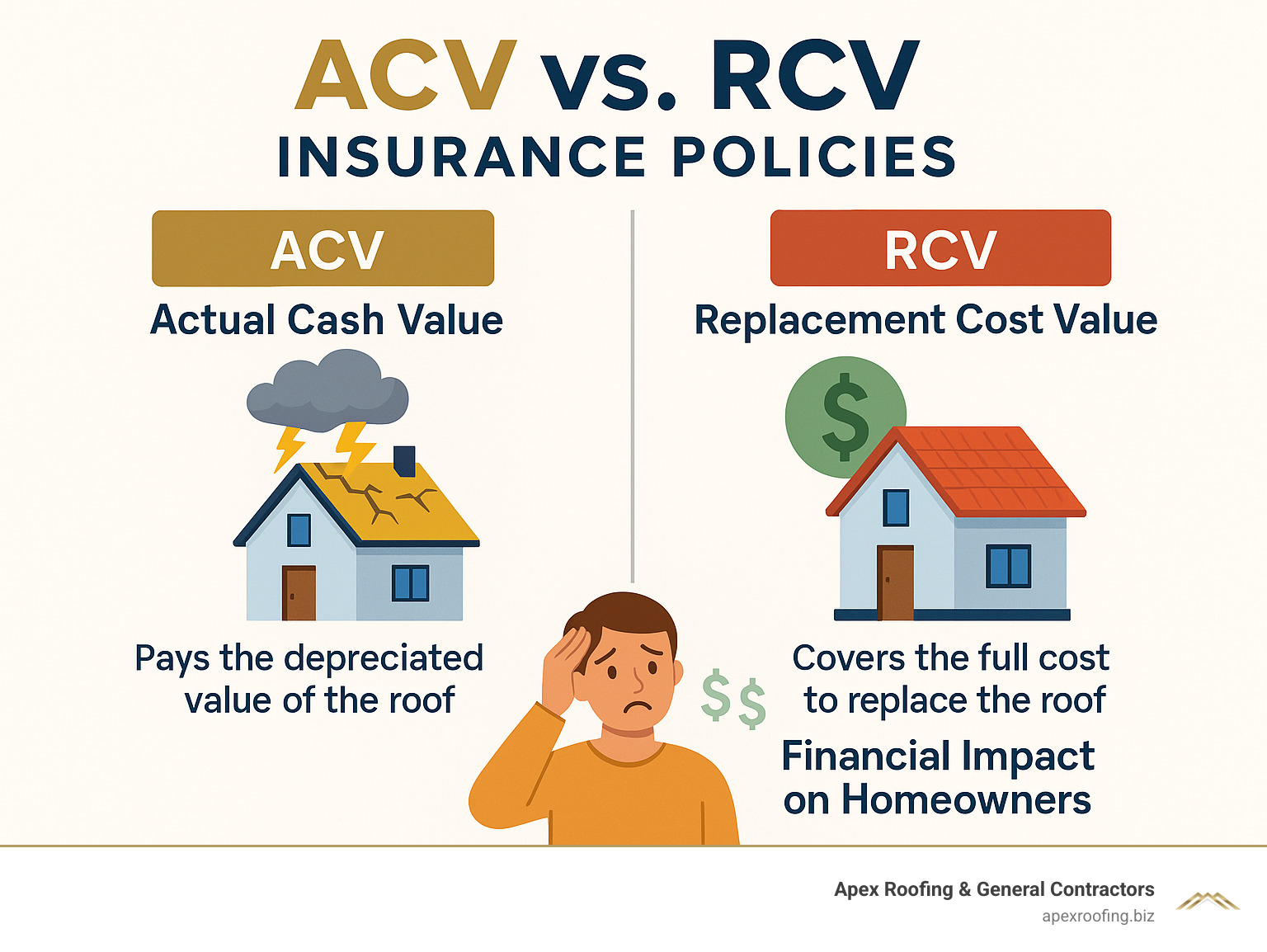
The Claims Timeline
Time is not on your side when it comes to filing claims. Most policies require you to report damage within 30-60 days. Here’s what typically happens:
First, you’ll need to contact your insurance company right after finding damage. They’ll send an adjuster to assess what happened. This is where having a trusted storm damage roofing company like Apex present during the inspection can be invaluable—they’ll spot damage the adjuster might miss.
After inspection, your insurance company provides their initial estimate of covered damages. Don’t be surprised if your roofing contractor identifies additional necessary repairs through what’s called the “supplement process.” Once everyone agrees on the scope of work, repairs can begin, and after completion, the insurance company releases any remaining funds.
Tips for a Successful Claim
Know your deductible before disaster strikes. In Texas, homeowners typically pay around $1,000 or more out-of-pocket before insurance kicks in. Understanding your coverage limits is equally important—some policies cap roof coverage or exclude certain types of damage.
Whenever possible, be present during both the adjuster’s and contractor’s inspections. Two sets of eyes are better than one, and you’ll learn exactly what’s happening with your home. Keep detailed records of everything—photos, estimates, emails, phone calls, and receipts. This documentation is your best friend if disputes arise.
If the initial offer seems low, don’t just accept it. Insurance companies sometimes miss damage that professional roofers can identify. That said, be wary of contractor schemes. In Texas, it’s illegal for contractors to “waive” or “cover” your deductible—this can result in up to 6 months of jail time and a $10,000 fine for the contractor. If someone offers this, run the other way!
Finally, remember to submit proof of completion to receive your recoverable depreciation if you have an RCV policy. The insurance company needs verification that repairs were actually completed as agreed.
For more detailed guidance on navigating roof storm claims, check out our storm damage repair guide.
If your damage resulted from a declared disaster, you might qualify for additional help through FEMA’s disaster assistance program. These resources can be a lifeline when insurance doesn’t cover everything.
How to Select the Best Storm Damage Roofing Company
When severe storms roll through San Antonio, the phones start ringing off the hook at local roofing companies. In fact, after major weather events, most roofing contractors see service calls jump by a whopping 300%. This sudden surge creates the perfect storm (pun intended) for both legitimate professionals and opportunists looking to make a quick buck. That’s why knowing how to choose a reputable storm damage roofing company isn’t just important—it’s essential for protecting your home and wallet.
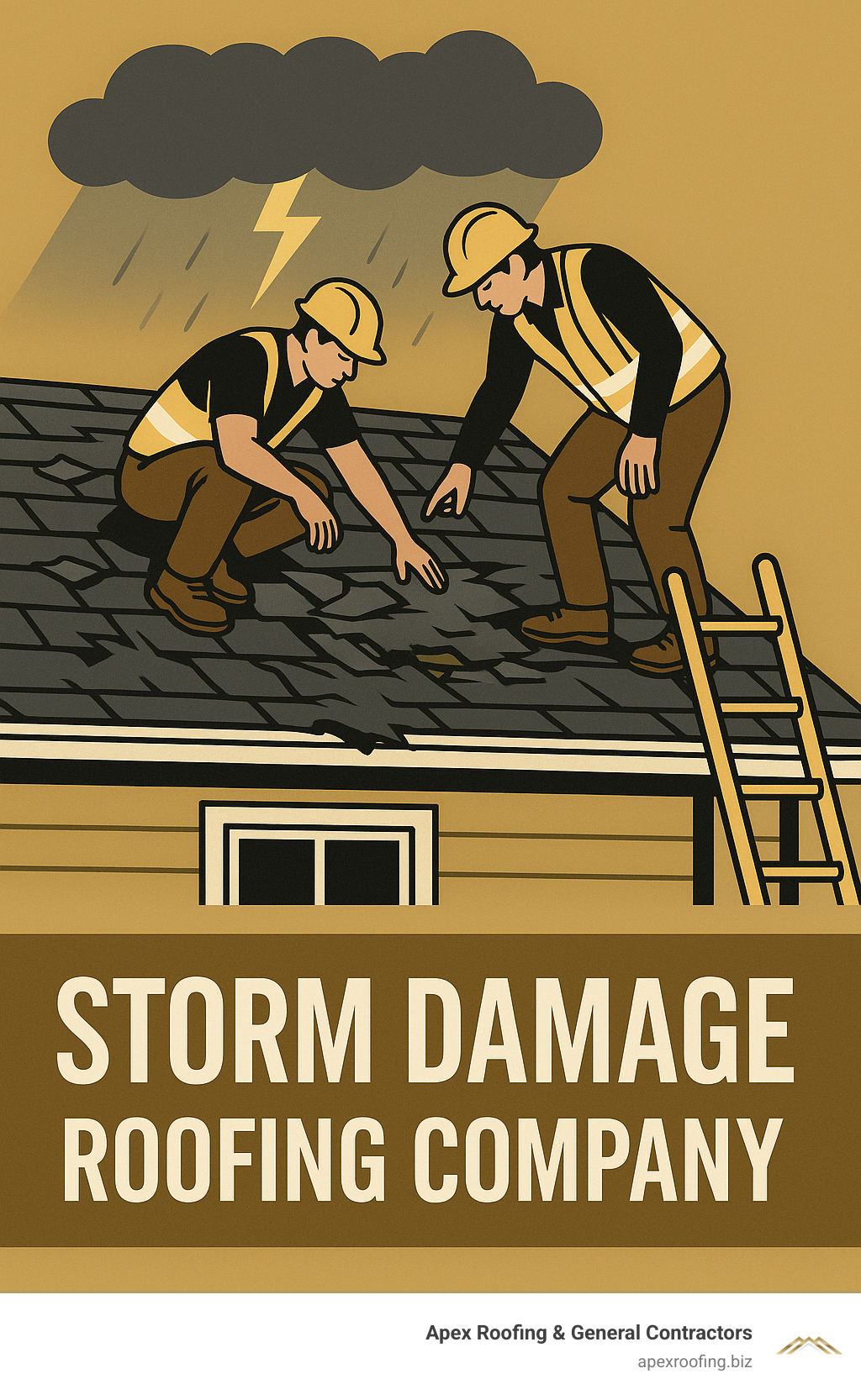
Essential Criteria for Choosing a Roofing Contractor
Finding the right storm damage roofing company starts with looking for strong local roots. A contractor with a permanent physical office in San Antonio shows they’re invested in our community and won’t disappear after the job. They should have a solid track record of happy local customers and active membership in local business organizations.
Proper credentials matter tremendously. Your roofer needs a valid Texas business license, substantial general liability insurance (at least $1 million), and workers’ compensation coverage. Without these protections, you could be liable if something goes wrong during your roof repair.
Manufacturer certifications speak volumes about a contractor’s expertise. Companies certified by major brands like GAF, Owens Corning, or CertainTeed have proven their skills and gained access to extended warranties that protect your investment. These certifications aren’t handed out freely—they require ongoing training and adherence to strict quality standards.
Clear, written warranties provide peace of mind that your roof repair will stand the test of time. Look for workmanship warranties of at least 5 years, with options for transferability if you sell your home. A trustworthy contractor will happily explain exactly what is and isn’t covered.
Given the complexity of insurance claims after storm damage, you need a storm damage roofing company with proven expertise in this area. They should be familiar with Xactimate (the industry-standard estimating software), have relationships with major insurance companies, and know how to identify all storm-related damage—not just the obvious problems.
At Apex Roofing & General Contractors, we take pride in exceeding these standards. You can verify our qualifications and credentials on our professional licensing page.
Red Flags: Avoiding Storm Chaser “storm damage roofing company” Scams
After hailstorms and high winds hit our area, you might notice an influx of unfamiliar trucks with out-of-state plates cruising through neighborhoods. These “storm chasers” follow severe weather patterns, swooping in to capitalize on homeowner distress before moving on to the next disaster-struck community.
Be wary of contractors who show up uninvited at your door right after a storm. Legitimate storm damage roofing companies are usually too busy helping established customers to go door-knocking. If you spot company vehicles with out-of-state plates or feel pressured to sign something immediately, these are bright red warning flags.
Perhaps the biggest red flag is any offer to “waive” or “cover” your insurance deductible. This practice isn’t just unethical—it’s illegal in Texas and can result in serious penalties including jail time and hefty fines. Similarly, requests for full payment upfront or the absence of a verifiable local office should make you think twice.
Many storm chasers have limited or non-existent online presence. Without reviews or a digital footprint, they can easily disappear after collecting payments, leaving homeowners with shoddy workmanship and no recourse when problems inevitably arise.
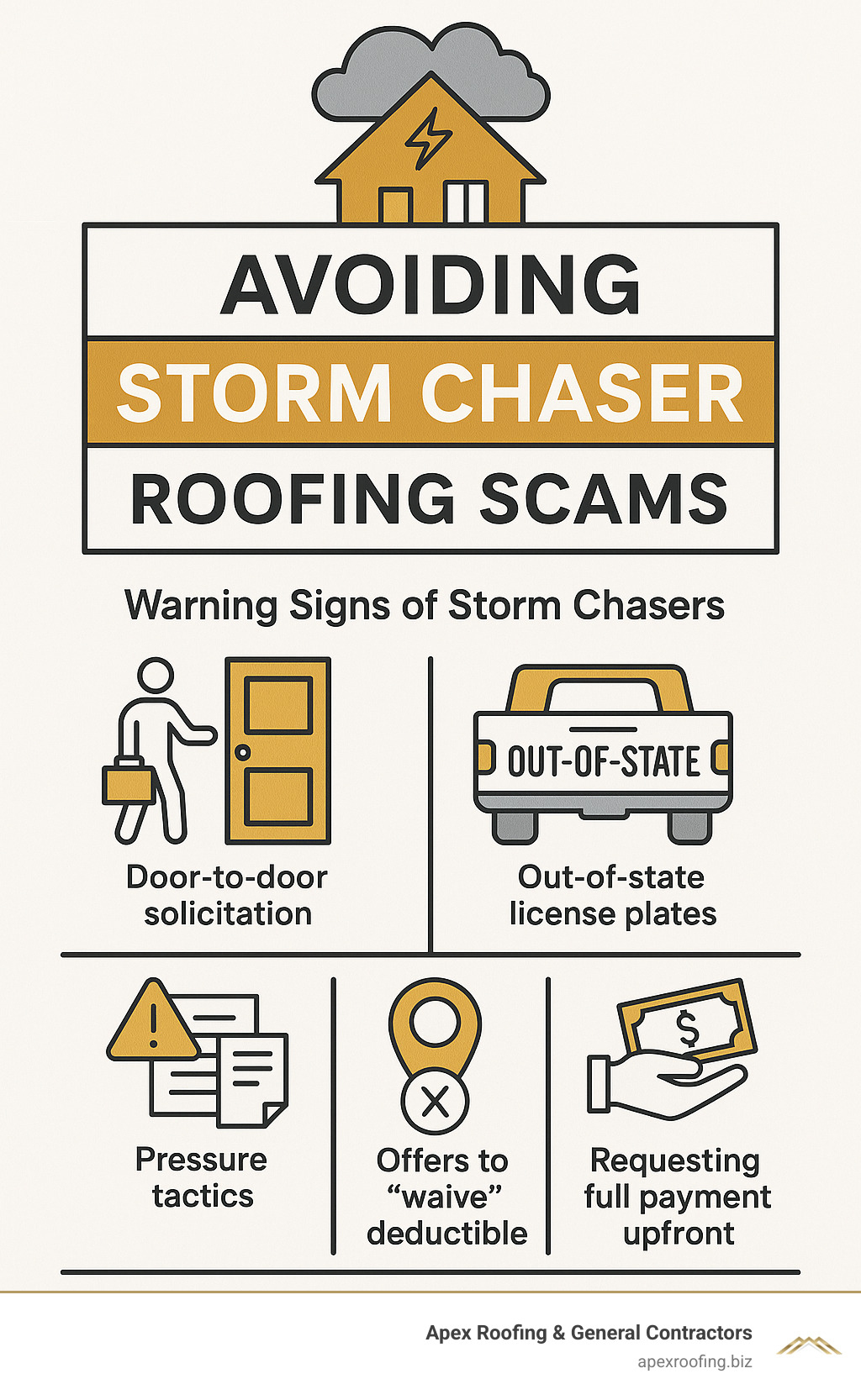
Must-Have Qualities of a Trusted Storm Damage Roofing Company
Beyond avoiding the bad apples, what should you actively look for in a storm damage roofing company? Transparency tops the list. Your contractor should provide clear, written estimates without hidden fees, keep you updated throughout the project, and answer all your questions honestly and directly.
Experience with storm damage repair isn’t something a company can fake. Ask to see a portfolio of similar projects, complete with before and after photos. Request references from local customers who’ve had storm damage work done, and make sure the company has specific experience with your roofing material, whether it’s asphalt shingles, metal, or tile.
The best storm damage roofing companies offer comprehensive services from start to finish. This includes free, thorough roof inspections, help navigating the insurance maze, emergency tarping to prevent further damage, and complete repair or replacement services. Having one trusted partner through the entire process reduces stress and ensures nothing falls through the cracks.
Quality materials make all the difference in how your roof performs during the next storm. Top contractors use premium, weather-resistant materials and can offer options for impact-resistant shingles that may qualify for insurance discounts. They’ll ensure proper ventilation and underlayment systems that comply with local building codes.
Finally, professional installation is non-negotiable. Your contractor should employ trained, experienced crews who follow proper safety protocols, clean up thoroughly after the job, and conduct a final inspection to verify quality. These details separate true professionals from fly-by-night operators.
Don’t just take our word for it—visit our reviews page to see what our clients say about our storm damage repair services. We’re proud of our reputation as San Antonio’s trusted storm damage roofing company.
Want to know if your roof has sustained storm damage? Call Apex Roofing & General Contractors at (726) 727-7663 to schedule a free inspection. We’ll provide a thorough assessment and honest recommendations with no obligation.
Long-Term Roof Resilience in South-Central Texas
Living in San Antonio and the Hill Country means your roof faces some unique weather challenges. From scorching summer heat to surprise hailstorms and seasonal high winds, our local climate can really put your roof through its paces. But with the right materials, regular maintenance, and proper installation, your home can stand strong against whatever Mother Nature throws at it.
Climate-Appropriate Materials for Storm Resistance
When it comes to protecting your San Antonio home, not all roofing materials are created equal. I’ve seen how the right choices can make all the difference during severe weather.
Impact-resistant shingles are worth every penny for Hill Country homeowners. These UL 2218 Class 4-rated shingles (the highest rating available) can withstand hailstones traveling at speeds up to 100 mph – a game-changer during our spring hailstorm season. Many of my customers love the SBS-modified asphalt options, which contain rubberized polymers that give them impressive flexibility and durability.
For homes that get the full force of those Texas winds, wind-resistant systems provide crucial protection. These systems use improved nail patterns and installation techniques that can withstand winds of 130+ mph. The special starter strips and improved perimeter installation make a world of difference when those summer thunderstorms roll through.
And let’s not forget about our brutal summer heat! Heat-reflective materials serve double duty by protecting your roof and lowering your energy bills. ENERGY STAR® rated products and cool roof technologies can significantly reduce attic temperatures, extending your roof’s lifespan and keeping your air conditioner from working overtime.
Preventative Maintenance for Storm Preparedness
A well-maintained roof is your best defense against storm damage. Think of it like regular oil changes for your car – a little prevention goes a long way.

I always recommend San Antonio homeowners schedule professional roof inspections twice yearly – ideally in spring and fall. These check-ups help catch minor issues before they become major headaches. Between professional visits, be sure to keep those gutters clean and free-flowing. Clogged gutters can cause water to back up under your shingles, creating the perfect conditions for leaks and rot.
Those beautiful oak trees that provide shade for your yard? They need regular trimming to keep branches from scraping against your roof during windy days. And while you’re at it, take a look at the flashing around chimneys, vents, and skylights – these areas are common entry points for water and often need resealing.
Proper attic ventilation is another critical factor that many homeowners overlook. Good airflow prevents moisture buildup and extends the life of your roofing materials. Our storm damage roofing company technicians are trained to spot ventilation issues that might compromise your roof’s performance during severe weather.
Code-Compliant Upgrades for Maximum Protection
Building codes evolve for good reason – they incorporate lessons learned from previous weather events. When repairing or replacing a storm-damaged roof, consider these important upgrades that might not have been part of your original roof installation.
Improved underlayment provides an essential second line of defense. Self-adhering ice and water shields in vulnerable areas offer superior protection against water intrusion. Modern synthetic underlayments have impressive tear resistance compared to traditional felt papers, making them much more effective during high winds.
Balanced ventilation systems with proper intake and exhaust components help regulate temperature and moisture levels in your attic. Ridge vents with external baffles resist wind-driven rain, while adequate soffit ventilation ensures proper airflow throughout the system.
The way your shingles are attached matters tremendously during storms. Secure attachment methods using ring-shank nails provide significantly greater holding power than smooth nails. Six-nail installation patterns (versus the standard four) can make the difference between your roof staying put or ending up in your neighbor’s yard during severe weather.
For a comprehensive assessment of your roof’s storm readiness, schedule a professional roof inspection with our experienced team at Apex Roofing & General Contractors. We’ll help you identify vulnerabilities and recommend specific improvements to protect your San Antonio home for years to come.
Don’t wait until after the storm to think about roof resilience. Call us today at (726) 727-7663 to schedule your free inspection and estimate. Our local experts understand South Texas weather patterns and can help you create a custom plan for long-term roof protection.
Frequently Asked Questions about Storm-Related Roof Repairs
How long does storm damage roof replacement take?
When your home has suffered storm damage, one of your first questions is likely about timing. After all, you want your home protected again as quickly as possible.
The reality is that storm damage roof replacement typically follows a sequence that takes several weeks from start to finish. After you contact a storm damage roofing company like Apex, we’ll conduct an initial inspection within 1-2 days. The insurance approval process usually takes 1-3 weeks, depending on your insurance company’s efficiency and current claim volume. Once approved, we’ll need 1-2 weeks for scheduling and ordering materials, followed by the actual roof replacement which typically takes 1-5 days depending on your roof’s size and complexity. We’ll finish with a thorough final inspection and cleanup.
Several factors might extend this timeline. After widespread storms hit San Antonio, demand for roofing services skyrockets, sometimes creating scheduling backlogs. Supply chain issues can affect material availability, especially for specialty roofing products. Weather conditions might delay installation (we won’t install your roof in the rain!), and sometimes we find additional damage during the process that needs addressing.
Rest assured that at Apex Roofing & General Contractors, we’ll provide you with a realistic timeline based on your specific situation and keep you informed every step of the way. We balance efficiency with quality craftsmanship—your roof is too important for rushed work.
What if my insurance claim is denied?
Receiving a claim denial can feel like a punch to the gut, especially when you’re dealing with obvious roof damage. Don’t lose hope—you have several options to pursue.
First, request a detailed explanation from your insurance company about why they denied your claim. Understanding their reasoning is crucial for your next steps. Once you know why they denied it, you can gather additional evidence to support your appeal. This might include a professional inspection report from a trusted storm damage roofing company, detailed photos and videos of the damage, weather reports confirming severe conditions on the date of the storm, and even statements from neighbors who had similar damage with approved claims.
In more complex cases, you might consider hiring a public adjuster who specializes in advocating for homeowners during insurance disputes. They typically charge a percentage of the claim amount but can be well worth it for substantial claims.
If your appeal is unsuccessful or your damage isn’t covered due to policy limitations, we can help you explore financing options for your roof repair or replacement. At Apex Roofing, we offer flexible financing solutions to help you protect your home even when insurance falls short. You might also consider home improvement loans or home equity lines of credit, depending on your financial situation.
For more details about our financing programs, visit our financing page or call us to discuss your specific needs.
Can maintenance really prevent future storm damage?
While no roof can be 100% storm-proof in the face of severe Texas weather, regular maintenance dramatically improves your roof’s resilience. Think of maintenance as preventive medicine for your home—addressing small issues before they become major vulnerabilities.
Regular professional inspections allow us to spot and fix minor problems before they compromise your roof’s integrity. These inspections are particularly important after severe weather events, even when no obvious damage is visible to the untrained eye. Our experienced technicians know exactly what warning signs to look for.
Prompt repairs of minor damage prevent water infiltration that can lead to structural issues, mold growth, and interior damage. Something as simple as replacing a few damaged shingles can prevent thousands in future repair costs.
Keeping your gutters clean and properly functioning protects your roof, fascia, and foundation from water damage. Proper attic ventilation maintenance extends shingle life by preventing heat and moisture buildup. And trimming overhanging tree branches eliminates potential projectiles during high winds.
Many homeowners don’t realize that regular maintenance is often required to maintain your manufacturer warranty coverage. Some insurance policies also look more favorably on claims when you can demonstrate responsible roof maintenance.
The bottom line? Regular maintenance by a qualified storm damage roofing company like Apex Roofing is one of the smartest investments you can make in protecting your home against future storms. It’s always less expensive to prevent damage than to repair it.
Ready to storm-proof your roof? Call us at (726) 727-7663 to schedule a free inspection and learn how we can help protect your home for years to come.
Conclusion
When fierce storms roll through San Antonio and the surrounding Hill Country, having a trusted local storm damage roofing company by your side makes all the difference between a stressful disaster and a smooth recovery. At Apex Roofing & General Contractors, we’ve helped thousands of homeowners bounce back from storm damage with quality repairs, honest communication, and expert guidance through those often–confusing insurance claims.
The numbers don’t lie – hail storms cause approximately $1 billion in roof damage each year across the country, and wind and hail damage account for nearly 34 % of all homeowners-insurance claims. Living in Texas, it’s not really a question of if your roof will face severe weather, but when. Being prepared with the right information and professional support ensures you can respond quickly when those dark clouds gather.
Remember these crucial points when storms strike:
- Document everything thoroughly with clear photos and videos of all damage – these visual records will be your best friend during the claims process.
- Reach out to a reputable local roofing contractor before filing your insurance claim – Apex Roofing can help identify all damage that should be covered.
- Understand whether your policy offers ACV or RCV coverage; this will significantly impact your out-of-pocket expenses.
After major storms sweep through, be extra cautious about those trucks with out-of-state plates suddenly appearing in your neighborhood. These storm chasers rarely have your best interests at heart. Instead, invest in regular maintenance and storm-resistant materials that can better protect your home during future weather events.
As your neighbors right here in San Antonio, Helotes, Leon Valley, Alamo Heights, Fair Oaks Ranch, Shavano Park, Terrell Hills, and throughout Bexar County, we’re committed to providing the highest-quality storm-damage repair services with both expertise and heart. We understand because we live here too – we face the same storms and know exactly what your roof is up against.
Don’t wait until the next storm hits. Schedule a free roof inspection today to assess your roof’s condition and storm readiness. Visit our emergency roofing services page or any of our service pages to learn more about how we can help protect your home from whatever Mother Nature throws your way.




